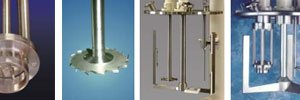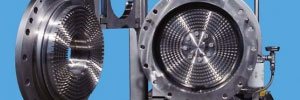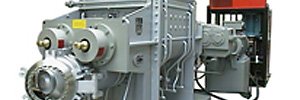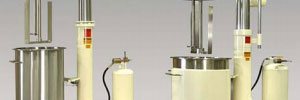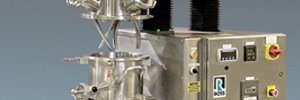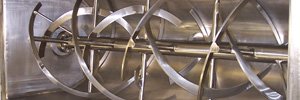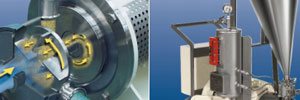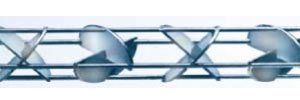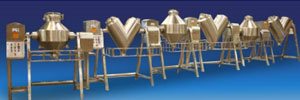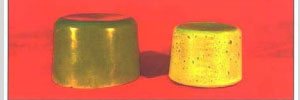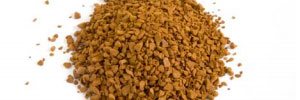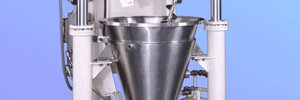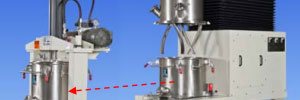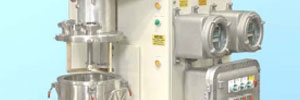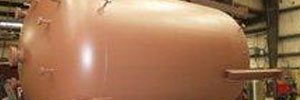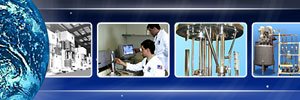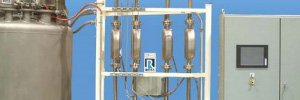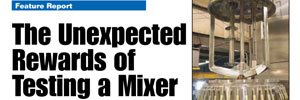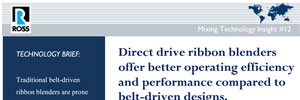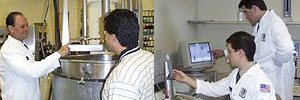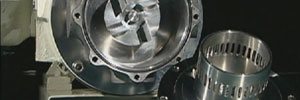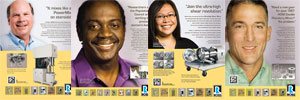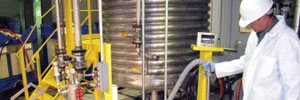Chemicals
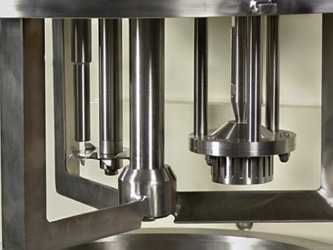
ROSS mixers, blenders, dryers and dispersers serve the requirements of the chemical industry in virtually every industrialized country around the world. We have the experience and production capacity that no other manufacturer of specialty mixing and blending equipment can match. Typical applications include low to high viscosity mixing, dry blending, particle size reduction, emulsification, homogenization, powder induction, vacuum processing and more.
- Abrasives - products developed to shape and finish surfaces in various applications including woodworking, autobody painting & repair, construction, personal products, etc. Typically, materials used as abrasives are either hard minerals (rated at 7 or above on Mohs scale of mineral hardness) or synthetic stones. Softer minerals like calcium carbonate are used as abrasives, such as "polishing agents" in toothpaste. ROSS Blenders efficiently mix, coat or vacuum dry abrasive powders. Our Multi-Shaft Mixers are suitable for preparing binder solutions for abrasives formulations.
- Asphalts - Modified asphalt is a blend of asphalt (bitumen) and fillers, such as calcium carbonate, and then modified by a polymer such as SBS rubber (styrenebutadiene-styrene block copolymer) or APP (atactic polypropylene). These polymers are often in pellet or crumb form and require very high shear conditions to soften and dissolve them into the asphalt at temperatures from 350 to 400F. The polymer modification gives the usually brittle asphalt improved mechanical characteristics such as tensile strength, elastic modulus and freeze/thaw stability - all are important factors for road paving applications. The processing of polymer modified asphalt using the ROSS Inline High Shear Mixer has been proven to be successful and is also applicable to other industries such as roofing and gasket manufacture.
- Chlorinated Organics - key ingredients in a wide variety of end products including paints and coatings, adhesives, pharmaceuticals, aerosols, dry-cleaning agents, degreasing solvents, etc. A ROSS customer offloads chlorinated hydrocarbon slurry from railcars and trucks. During transport some solids settle and agglomerate. The slurry is fed at 10 to 30 gpm to reactors that operate with 1/4" nozzles. In the past they used centrifugal pumps to offload this slurry. In an attempt to break down the solids, they recirculated the solution through the pumps -- obviously a waste of time and energy, and a purpose for which centrifugal pumps are not well suited. The solids still ended up plugging the reactor nozzles. Installation of several ROSS Model HSM-401 Horizontal Inline High Shear Mixers solved the problem. Agglomerates that can potentially clog the reactor nozzles are broken down as they pass through the rotor/stator interface. The presence of chlorine necessitated Hastelloy C materials.
- Coal Suspensions - In the processing of synfuel, powdered coal is combined with oil that is fed into the furnaces of large power plants. ROSS Inline High Shear Mixers have been proven very effective in this area. Also, our vacuum Double Planetary Mixers are ideal for drying coal and recovering solvents. The dried coal is used for making fire-resistant insulation boards and ablative coatings on aircrafts.
- Epoxy Hardeners - The building blocks of epoxy adhesives are essentially five: epoxy resins, hardeners, accelerators, fillers and additives. Cure is generally achieved using hardeners (co-polymerization). Hardeners then fall into two big categories: the ones for two-part epoxies which cure at room temperature, and the ones for one-part epoxies which require a form of energy to start the reaction (heat, light etc.). Common hardeners are polyamines, polyamides and polymercaptanes. In terms of performance, each hardener provides specific properties to the product. For example, polymercaptanes are generally used to cure the resin very quickly, polyamines to give high performance and polyamides for good adhesion, flexibility, relative insensitivity to mix ratio, and good health & safety classification. "Five minutes epoxies" which have 3 - 6 minutes of pot life generally contain polymercaptane hardeners. High temperature two-part resins, which are characterized by superior resistance to thermal environments, often contain polyamine adducts. A 1000-gal ROSS VersaMix services one of the biggest epoxy hardener production plants in the world.
- Fertilizers - ROSS Inline High Shear Mixers with Solids/Liquid Injection Manifold (SLIM) are installed and successfully operated in fertilizer production plants for introducing solids into low-viscosity fluids such as induction of silicon dioxide (diatomaceous earth) into phosphoric acid for stripping of fluorine.
- Flotation Reagents - Flocculants are chemicals that are specifically designed to form agglomerations, usually in an aqueous medium, such as wastewater. When the compound to be removed comes in contact with the flocculent, an agglomeration is formed. The resultant agglomerate can then be filtered and removed from the effluent stream. Two ROSS Inline Mixer Emulsifiers, Model HSM-4100 (100 HP) are in service at a client's facilities, each producing 3000 gallon batches of polyelectrolyte-based flocculants. The manufacture of polyelectrolyte-based flocculants involves bringing together a 4-constituent aqueous phase with a 3-constituent oil phase. The two phases are introduced to the 3000 gallon tank. The batch is recirculated through the 100 HP mixer emulsifier, until complete - approximate batch time is 2.5 hours. When the batch is finished, the flocculant is again pumped through the Mixer Emulsifier, on its way to a storage vessel. The finished product is shipped to industrial and municipal wastewater treatment facilities via bulk tankers and also in 55-gallon drums. Application note: Both units referenced in this case history are reportedly working extremely well. They have been operating successfully for over 15 years.
- Lubricant Pastes and Oils - A manufacturer of oil-based lubricating grease is using asphaltic oil, to which they add organic acids and aluminum isopropoxide powder to thicken the oil into a grease product. Large turbine-agitated vessels were utilized to make this product, however the addition of AIP, which is a dusty solid, created an environmental issue. The ROSS inline SLIM offered them an improved way of introducing the AIP powders into heated asphaltic oil.
- Optical Brighteners - Cyanuric chloride, C3N3Cl3, is a key ingredient in Optical Brighteners. These find use in the textile industry for intensifying color in cotton and regenerated cellulosic fibers. The effect of optical brighteners is to absorb invisible UV-light and emit visible light primarily in the blue spectral range. Yellow or yellowish substrates appear whiter when more bluish light is emitted. In a customer's expansion project, a 2,500-gallon ROSS VersaMix became the equipment of choice over their existing single shaft turbine-type mixers. The Three Wing Anchor of the VersaMix provides mass flow while the High Shear Mixer promotes deagglomeration and dispersion of solids. Lumps 100-200 microns in size must be broken apart. A single-blade mixer is inferior to the VersaMix because effective mixing would be confined to certain areas in the tank, especially for large batch volumes such as this one. A colorless crystal with pungent odor, C3N3Cl3 reacts violently with water producing cyanuric acid, hydrochloric acid and heat. Hence, the vessel is insulated and sheathed in stainless steel.
- Precious Metals - At some point in the manufacture of catalytic converters, a clean out is done whereby products are washed with water. Rinse water is recycled and stored due to the presence of precious metal residue. During storage the metal particles settle. A ROSS High Speed Disperser effectively agitates this soup, keeping the precious metals suspended and dispersed within the rinse water before it is sent to a drier. Metals recovery is critical because these catalysts are very expensive.
- Propellants - ROSS Planetary Mixers are widely used for making composite propellant pastes and slurries made from solid oxidizers such as ammonium perchlorate or ammonium nitrate, powdered metal fuel such as aluminum, rubber, cellulose, epoxy, and/or other fuel/binder compounds.
- PVB Emulsions - aqueous polyvinybutyral dispersions are used as decorative, protective or temporary coatings for paper, metal, wood or glass. A sample blend consists of viscous oil plasticizer, surfactant and powdered PVB polymer resin. Suitable equipment for this application are Kneader Extruders and Planetary Mixers.
- Technical Polymers - One ROSS customer, a multi-billion dollar chemical & pharmaceutical company, uses the Model VM-100 as a mixer/reactor in its R&D efforts to further broaden their range of high-performance polymers and meet the evolving needs of the market. Their resins are vacuum-formed, injection-molded or machined into products designed for a variety of demanding applications. Engineering polymers can be classified into two groups: amorphous and semicrystalline. Amorphous polymers are generally transparent, feature high dimensional stability, good chemical resistance and toughness. Semi-crystalline polymers are usually opaque and exhibit excellent fatigue resistance. Processing of engineering polymers requires high pressure and temperature, tightly sealed mixer/reactor vessels highly resistant to chemical degradation, jackets for optimum heat transfer, and clog-free discharge systems.
- Thermal Transfer Grease - used as heat transfer material in central processing units of computers, other appliances, and vehicles. A client used to make their greases in single planetary mixers without much efficiency. After addition of each ingredient, it was necessary to scrape the bottom and sides of the pot and the blades. For their formulation, excess heat must be avoided to prevent formation of formaldehyde, an unwanted by-product. Successful lab tests confirmed that the ROSS DPM with HV Blades is very appropriate for this application. The costumer was then able to optimize the packing fraction of the greases.
- Pesticide Gel Production in a ROSS VersaMix Triple-Shaft Mixer
Herbicides and insecticides in gel form enable easy, accurate and controlled application for increased efficacy and safety. Compared to traditional pesticides that are sprayed or sprinkled, gel formulations are smeared onto targeted surfaces which reduces the risk of chemical runoff and contamination. - Recommended Mixing Equipment for Polyvinyl Alcohol Solutions
Polyvinyl alcohol (PVOH, also referred to as PVA) is a versatile polymer that plays multiple roles in the manufacture of adhesives, sealants, cosmetics, paper, textiles and many other products. - Recommended Mixing Equipment for Catalytic Slurries
Catalytic slurries consisting of solid catalysts and support materials suspended in a liquid medium are commonly prepared in batch tanks agitated by low-speed mixers such as propellers, anchor paddles and pitched blade impellers. These devices can sometimes suffer from long cycle times and inadequate dispersion especially in large batches. - Recommended Mixing Equipment for Metal Soap Dispersions
Metal soaps such as calcium stearate and zinc stearate are available in the form of a powder or a dispersion containing high percent solids. - Recommended Mixing Equipment for Clay Dispersions
When suspended in liquid, certain clays provide bonding, plasticizing, thickening or suspending properties. - Dissolve solids rapidly.
Consider high-speed sub-surface solids injection for demanding and high-volume dissolution requirements.. - Benefits of ultra-high shear mixing batch mixing and homogenization in the chemical industry
Consider an ultra-high shear rotor/stator mixer for your process. Compared to other batch style mixers including high speed dispersers, traditional rotor/stator mixers and immersion mills, an ultrahigh shear mixer delivers more superior particle or droplet size reduction.. - Upgrade your colloid milling operation
New ultra-high shear mixers offer improved performance and efficiency over traditional colloid mills. Advantages include higher throughput, greater particle size reduction, easier cleaning and lower capital cost. - Preparing wet granulations in a planetary mixer
Planetary mixers are ideal for wet granulation processes. Advantages include "one-pot" processing, high uniformity and yield, predictable performance, and ease of cleaning. - Mixers for continuous dilution
processes
Static mixers and rotor/stator mixers are utilized for truly continuous in-line dilution of concentrated solutions. Advantages include high throughput, low space requirement, easy installation, performance predictability and low maintenance.. - Preparing for a mixing trial.
Simulation trials are useful experiments that help identify the right mixer for a specific application and predict machine performance. This bulletin discusses some preparation ideas for a smooth and productive mixer testing. - Reduce foaming and air
entrapment during mixing.
Foaming and air entrapment are common phenomena encountered in many mixing processes. Different applications call for different solutions, including addition of chemical defoamers, mixing under vacuum and high-speed sub-surface powder induction.. - Mixing dilatant materials
Dilatant materials pose a unique mixing challenge due to their very nature: the greater the shear forces applied to the material, the more resistance is encountered. Heavy-duty, high-torque double planetary mixers operated under comparatively low speeds are ideal for processing shear-thickening mixtures. - Preparing wet granulations in a planetary mixer
Planetary mixers are ideal for wet granulation processes. Advantages include "one-pot" processing, high uniformity and yield, predictable performance, and ease of cleaning. - Inline mixing of gases and liquids
Efficient mixing of gases and liquids is a critical step in many chemical and biological process technologies. Static mixers and inline rotor/stator mixers are typically used in gas-liquid applications where high intensity mixing, short contact time and/or continuous processing are required. - Control system options for explosion-proof mixers
Multiple options are available for explosion-proof controls of mixing systems installed in hazardous environments. To select the best and most cost-effective controls solution, it helps to work with an experienced control designer who knows the details of your process as well as the mixing system and auxiliary equipment involved. - Mixing abrasive pastes and
slurries
Dispersion of abrasive solids into liquid can be accomplished in single-shaft, multi-shaft or planetary mixers, depending on product rheology and degree of abrasion. This bulletin discusses some strategies for combating abrasive wear in these types of mixers. - Scale-up of batch mixers
Successful scale-up of specialty mixing equipment often relies less on straightforward formulas and more on empirical data and experience. This bulletin discusses some practical tips and considerations useful in the scale up of batch mixing operations.. - Multi-agitator mixer/reactors
Multi-agitator mixers are ideal for reaction processes that require intense mixing, high speed dissolution, emulsification, deagglomeration or heating/cooling of viscous liquids. - Select a powder induction mixer that can serve multiple mix tanks of virtually any size.
An inline rotor/stator mixer equipped for powder induction offers flexibility, capability and portability to serve multiple mix vessels of virtually any size. Its straightforward operation and convenience further maximize equipment utility while simplifying material handling. - Ribbon blenders are ideal for coating and mixing processes.
Solid-solid mixing sometimes involves powders that need to be uniformly coated with smaller particles of a different component. The ingredient that is coated onto the bulk material is typically a very small percentage of the batch, thus requiring thorough and uniform blending. Ribbon blenders are proven to be highly effective for these coating and mixing operations. - Improve emulsion stability through ultra-high shear mixing.
The droplet size distribution of an emulsion largely dictates its stability. Fine droplet sizes are produced by applying sufficient shear, often through the use of conventional rotor/stator mixers. Today, ultra-high shear rotor/stator designs are available which can improve emulsion stability of certain formulations. - High speed mixing: saw-tooth dispersers vs. rotor/stator mixers
The saw-tooth disperser and rotor/stator mixer are two of the most widely used high speed mixers yet many are unaware of the differences in their utility and operating capacities. Knowing the unique attributes of these devices is important in mixer selection and process optimization. - Eliminate “fish eyes” in your mix.
Inefficient mixing can lead to agglomerates and “fish eyes” which are difficult to disperse once formed. Using a high shear mixer equipped for powder induction helps prevent the formation of agglomerates, maximizes yield and cuts cycle time. - Use of powder induction mixing technology can significantly reduce raw material costs.
An efficient mixing system with powder induction capability enables manufacturers to optimize raw material costs in two ways: by allowing them to source and handle ingredients in dry form rather than the more expensive liquid form; and by maximizing yield of all powder components. - Inline high shear mixers instantly boost batch production without disturbing existing equipment.
Many batch mixing processes can be optimized with the addition of an inline rotor/stator mixer. The supplemental agitation and shear provided by an inline mixer boosts production by reducing cycle time. Multiple batch tanks can be serviced by a single inline mixer and benefit from its pumping capabilities. Another practical advantage to an inline mixer is that it is easily installed without disturbing pre-existing equipment. - Run your rotor/stator mixer at maximum speed to optimize emulsification & particle size reduction.
Generally, the maximum speed setting of a rotor/stator mixer provides the optimal mixing results in terms of particle or droplet size reduction. Once an equilibrium size distribution is reached, subsequent passes through the rotor/stator give diminishing returns. For applications that are processed at the maximum speed of a traditional rotor/stator mixer but still fall short of the desired particle or droplet size, a move to higher energy devices, such as ultra-high shear mixers, is recommended. - Ultra-high shear mixers increase overall throughput and efficiency of homogenization processes
Ultra-high shear rotor/stator systems speed up cycle time by reducing the number of passes required through a high pressure homogenizer, an inherently low-throughput, high-energy device. Since homogenizers are also generally maintenance-intensive, an efficient ‘pre-mixer’ generates significant savings in the overall cost of production. In certain applications, ultra-high shear mixers even offer a viable alternative to homogenizers. - Apply high speed powder
induction to eliminate dusting
in the mixing area
The release of airborne particles into the plant atmosphere when powders are added to a mix vessel leads to significant maintenance costs and safety concerns. A high speed induction device can eliminate dusting and accelerate both production and process changeover.

